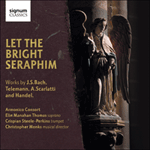
Welcome to Hyperion Records, a British classical label devoted to presenting high-quality recordings of music of all styles and from all periods from the twelfth century to the twenty-first.
Hyperion offers both CDs, and downloads in a number of formats. The site is also available in several languages.
Please use the dropdown buttons to set your preferred options, or use the checkbox to accept the defaults.

| Elin Manahan Thomas (soprano), Crispian Steele-Perkins (trumpet), Armonico Consort, Christopher Monks (conductor)» More |
The majority of Scarlatti’s cantatas are for solo voice, usually with only continuo for accompaniment. However, contemporary trends increasingly moved towards the addition of instrumental accompaniments, and around sixty of Scarlatti’s cantatas use extra instruments. Usually that instrumental backing is of strings, but occasionally his works also require recorders or trumpets. Su le sponde del Tebro contains a particularly demanding part for obbligato trumpet, playing in a high tessitura which suggests that there was a fine player around with the considerable stamina required to play the arias which partner soprano with trumpet. The story is the classically despondent one of unrequited love, and the form the usual alternation of arias and recitatives prefaced by a short sinfonia. The arias with trumpet are steadfast in their sentiments, and there is a brave (and partly successful) attempt to make the ground bass at ‘Dite almeno’ interesting, but it is the dissonances of the meltingly beautiful aria ‘Infelici miei lumi’ which show Scarlatti at his finest.
from notes by Robert King © 1996
La majorité de ses cantates sont pour voix seule, habituellement avec un continuo pour tout accompagnement. Cependant, les courants de l’époque tendirent sans cesse à l’ajout d’accompagnements instrumentaux et une soixantaine de cantates de Scarlatti font appel à des instruments supplémentaires. Ordinairement, ce fond instrumental échoit aux cordes, mais Scarlatti requiert parfois des flûtes à bec ou des trompettes. Su le sponde del Tebro recèle une parde particulièrement exigeante pour trompette obbligato, dans une tessiture élevée, ce qui semblerait indiquer qu’il y avait alors un excellent instrumentiste, doté de la remarquable résistance exigée par les arias qui accompagnent la voix soprano. L’histoire est celle d’un amour non partagé, classiquement désespéré, tandis que la forme reprend l’habituelle alternance d’arias et de récitatifs, préfacée par une courte sinfonia. Les arias avec trompettes sont constantes dans leurs sentiments et «Dite almeno» présente une courageuse (et en partie réussie) tentative de rendre la basse contrainte intéressante. Mais ce sont les dissonances de l’aria «Infelici miei lumi», délicatement merveilleuse, qui dévoilent le meilleur de Scarlatti.
extrait des notes rédigées par Robert King © 1996
Français: Hypérion
Die meisten von Scarlattis Kantaten sind für Solostimme und, wie üblich, mit der Begleitung eines Continuo komponiert. Jedoch bewegte sich der zeitgenössische Trend immer mehr zu einem Hinzufügen anderer Instrumentalbegleitung hin. Ungefähr sechzig von Scarlattis Kantaten benutzen eine andere Instrumentalbegleitung. Normalerweise bestand diese aus Streichern, doch Scarlatti setzte in seinen Werken zuweilen auch Blockflöten oder Trompeten ein. Su le sponde del Tebro enthält eine besonders anspruchsvolle Stimme in hoher Tonlage für die obligate Trompete, und es scheint damals ein großartiger Musiker gelebt zu haben, der das notwendige, beträchtliche Durchhaltevermögen besaß, um in einigen der Arien die Sopranstimme auf der Trompete begleiten zu können. Unerwiderte Liebe ist das klassische, melancholische Thema der Handlung, und die Formgestaltung hält sich, von der Einführung mit einer kurzen Sinfonie abgesehen, an die übliche wechselnde Abfolge von Arie und Rezitativ. Die Arien mit Trompetenbegleitung sind in ihrer Gefühlswelt unerschütterlich, und es wird ein tapferer Versuch (der zum Teil recht erfolgreich ist) am Basso ostinato des „Dite almeno“ unternommen, um dieses interessanter herauszustellen, während die Dissonanz der dahinschmelzend schönen Arie „Infelici miei lumi“ einen Scarlatti präsentiert, wie er besser nicht hätte sein können.
aus dem Begleittext von Robert King © 1996
Deutsch: Ute Mansfeldt
 Let the bright seraphim Let the bright seraphimThe Armonico Consort return to Signum with a new album celebrating the glorious combination of soprano and trumpet in baroque music›featuring the soaring talents of Elin Manahan Thomas and Crispian Steele-Perkins.» More |

